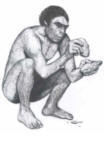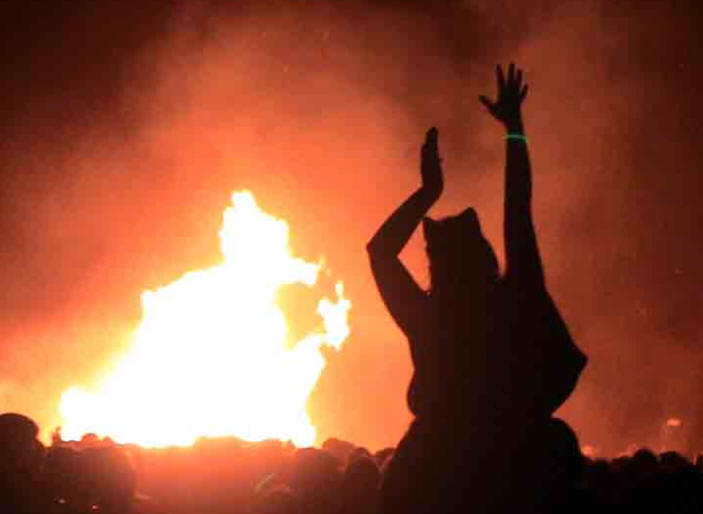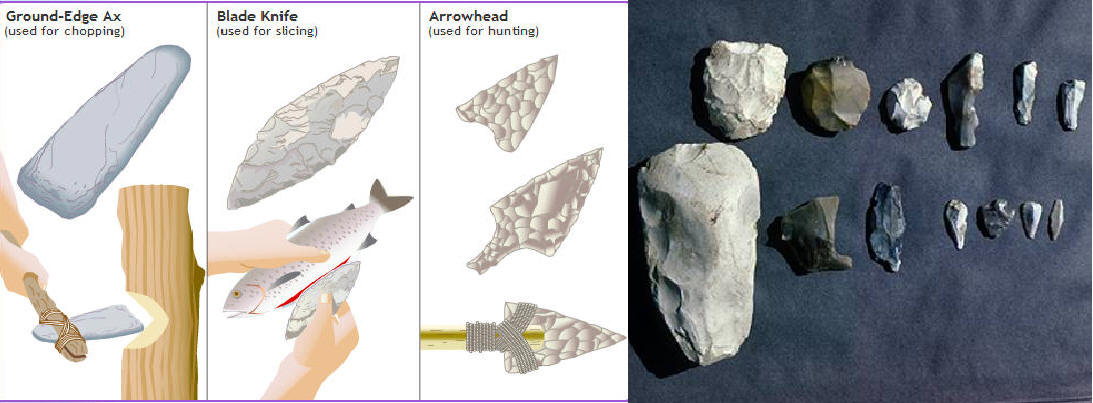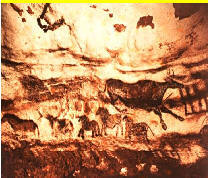

|
|
Word Builder
| Roamed | wander ,
travel unsystematically . |
| Hunting | pursue (search and kill) wild animals for food or sports |
| Weapons | any instrument or device for use in attack or defense in combat, fighting, or war, as a sword, rifle or cannon |
| Discover | to make known |
| Invent | to find out (by study ) for the first time |
| Shelter | to protect |
| Worshipping | to perform religious service |
| Spear | A long pointed weapon used in war and hunting (Link) |
Answer the following questions in brief.

1.How did early man discover fire ?
Early man could have discovered fire through a forest fire.
2.Mention two ways by which early man made fire?
a.
By
rubbing two bamboo sticks.

b. Sparks from striking two stones .
3.How did fire change the life of man ?
Early
man could protect himself from
wild animals and also keep himself warm. He also
began eating food cooked in fire .
4. Why did human beings start living in caves?
Human
beings started living in caves to protect themselves from rain heat and cold.
5. How was the
invention of spear useful to early man?
The
use of spear helped the early man to keep a safe distance from animals while
hunting. The spear could also travel quite far.
1. The early Human being did not wear any clothes.
2. They searched for stones that could be cut and shaped into objects.
3. A spear travels fast and far.
4. Ancient men protected themselves from cold with animal skin.
5. Rubbing two bamboo stick can produce fire.
Write True or False
1. Early Human beings lived in caves.
2. Early human beings wore woolen cardigans to protect themselves from the cold.
3. They could cook their food on the gas even on those days.
4. Early Human beings used to kill animals with guns.
5. Some people still worship fire.
Activity
List six ways in which early human beings were different from us. Paste an illustration of early human beings. On the other side paste a photograph of today’s human beings to bring out the difference.
| Habitat | Early Human Being | Today's Human Being |
| Housing | in Care and Trees
|
Houses Made of Cement and Bricks
|
| Food | Hunting for animals
|
Agriculture and rearing of animals
|
| Clothing | Wear No clothes or use animal hide or plant leaves
|
Wear clothes like pants and shirts made of cotton, wool
|
| Cooking | Ate raw flesh
|
Use fire for cooking and melting iron for making tools
|
| Communication | Use of Drum or fire
|
Use of electronic & Print Media
|
| Transportation | Use of animal & foot
|
Use of vehicles as BUS, Trains, planes, etc which are very
fast
|
| Weapons | Use of sharp stones & spears for hunting
|
Use of sophisticated weapons like guns and bombs
|
Man’s Greatest discovery – which is still worshipped ?
Prehistoric men knew about fire. They must have discovered it by chance, perhaps when lightening caused a fire or when the sun, shining on dry leaves, caused them to ignite. To our ancestors, the discovery of fire was a important as the discovery of electricity or atomic energy has been to us. It was so important that to the primitive mind of early man it seemed holy, a gift from the gods, and become the subject of many myths. In ancient mythology fire worship reappears often.
One of the ways in which prehistoric men made fire was by rubbing two pieces of wood together. It could also be done by rubbing two flint stones together.
Once man has discovered fire, he could warm himself in front of the flames and cook the flesh of animals (previously he had eaten meat raw). Fire bought light into the dark caves. As time went by and men lived in houses, a fire in the hearth helped to create a homely atmosphere.
With the aid of fire, men could build furnaces into which they put iron or a variety of other substances, mixed with charcoal. they used bellows to make the fires hotter and so were able to fashion tools for many purposes.
For many centuries man used fire to help him with the task of everyday life, although he did not learn to control it completely until the invention of fuel ignition systems, without which modern industry could not function.
Thanks to fire, was able to manufacture files, saws, axes, hammer, anvils, tongs and deadly weapons. He also leant how to make glass. So the discovery of fire was of vital importance in the history of humanity. But such a powerful element has its dangers as well as its advantages. It can do us a great deal of good but can also bring disaster. Think of example of how we heat our buildings: they are comfortable to live in, but if something goes wrong a fire can break out and cause great destruction
Fire Worship

Videos on related field
Want to know how Early man made Tools for Hunting ?
http://encarta.msn.com/encnet/refpages/RefMedia.aspx?refid=461542218
You can do too? Demonstration of how a stone tool is made
https://www.youtube.com/watch?v=aOlJ3dgq-1I
Humans first made tools of stone at least 2.5 million years ago, initiating the so-called Stone Age. The Stone Age advanced through three stages over time—the Paleolithic (which is subdivided into Lower, Middle, and Upper periods), Mesolithic, and Neolithic. Blade toolmaking, as demonstrated in this video, was a development of the Upper Paleolithic, which began about 40,000 years ago. This technique produced a far greater variety and higher quality of tools than did earlier methods of toolmaking

The Cave Paintings- The Early Human as an Artist

For entertainment and communication Early Human used to draw paintings on the walls for the caves where he lived. Wonder what they used for drawing ???? Well Mostly carbon balck and iron oxide (red colour) as found in earth – dirt. Want to know more – click here !!!
In India , 40 kms from Bhopal in Madhya Pradesh , Prehistoric rock paintings have been found at Bhimbetaka
